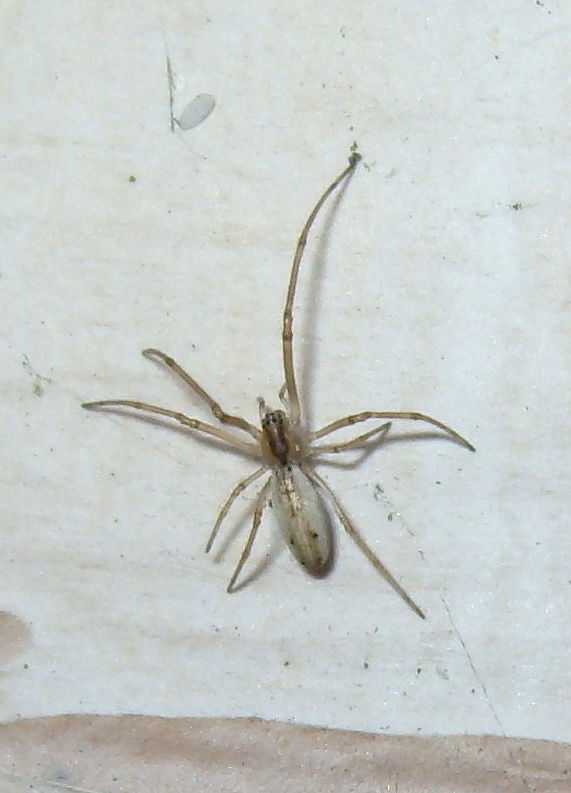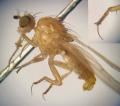Diptera.info :: Identification queries :: Other insects, spiders, etc.
Who is here? 1 guest(s)
|
spider
|
|
| mariki |
Posted on 18-02-2008 12:45
|
|
Member Location: Eindhoven Netherlands Posts: 388 Joined: 06.12.07 |
Cannot find the ID Eindhoven (The Netherlands) 7-02-2008 on a bark of a birch. size of the body 5-6 mm Thanks in advance mariki attached the following image:  [179.97Kb] |
|
|
|
| jorgemotalmeida |
Posted on 18-02-2008 14:24
|
|
Member Location: Viseu - PORTUGAL Posts: 9296 Joined: 05.06.06 |
This is a Tetragnathidae spider. Tetragnatha sp. juvenile. With specimen it is not possible to reach species level unless it reaches imago phase.  |
| zcuc |
Posted on 19-02-2008 21:29
|
|
Member Location: Israel Posts: 492 Joined: 08.10.07 |
How it's possible to tell a spider is juvenile? It's simple with flying insects but spiders always look the same  |
|
|
|
| Juergen Peters |
Posted on 20-02-2008 00:55
|
|
Member Location: northwest Germany Posts: 14332 Joined: 11.09.04 |
Hello, zcuc! zcuc wrote: How it's possible to tell a spider is juvenile? It's simple with flying insects but spiders always look the same  1.) From the size (adult Tetragnathas from species which come into account are bigger than 5-6 mm), 2.) from the "general jizz", and 3.) most importantly  : there are no adult Tetragnathas in the Netherlands in February - so this must be a juvenile (of the species T. montana or extensa, which are adult in late spring/early summer; I would vote for T. montana, which is very numerous here at the moment and does not only reside besides water like extensa). : there are no adult Tetragnathas in the Netherlands in February - so this must be a juvenile (of the species T. montana or extensa, which are adult in late spring/early summer; I would vote for T. montana, which is very numerous here at the moment and does not only reside besides water like extensa).
Best regards, Jürgen -=-=-=-=-=-=-=-=-=-=-=-=-=-=-=-= Juergen Peters Borgholzhausen, Germany WWW: http://insektenfo... -=-=-=-=-=-=-=-=-=-=-=-=-=-=-=-= |
| mariki |
Posted on 21-02-2008 21:24
|
|
Member Location: Eindhoven Netherlands Posts: 388 Joined: 06.12.07 |
Thanks for your replies. There is an area of water not too far, maximum 10 m away of the birch. I do not know how close of the water T. extensa is supposed to live. I have also profile picture of the spider, can it help for the determination of the species? Thank you in advance. |
|
|
|
| Juergen Peters |
Posted on 21-02-2008 21:55
|
|
Member Location: northwest Germany Posts: 14332 Joined: 11.09.04 |
Hello, mariki! mariki wrote: water not too far, maximum 10 m away of the birch. I do not know how close of the water T. extensa is supposed to live. 10 m would be near enough. I doesn't need to be so near - horizontal net over the water - like this one...: http://insektenfo...adid=10609 http://www.foto-u...enke_1.jpg  I have also profile picture of the spider, can it help for the determination of the species? I'm afraid that would not help, sorry. The two species can only be identied definitely by examination of the genitalia (female epigyne or - preferably - male palpi). And that wouldn't work with a juvenile anyway... Best regards, Jürgen -=-=-=-=-=-=-=-=-=-=-=-=-=-=-=-= Juergen Peters Borgholzhausen, Germany WWW: http://insektenfo... -=-=-=-=-=-=-=-=-=-=-=-=-=-=-=-= |
| jorgemotalmeida |
Posted on 22-02-2008 12:37
|
|
Member Location: Viseu - PORTUGAL Posts: 9296 Joined: 05.06.06 |
Juergen Peters wrote: Hello, zcuc! zcuc wrote: How it's possible to tell a spider is juvenile? It's simple with flying insects but spiders always look the same  1.) From the size (adult Tetragnathas from species which come into account are bigger than 5-6 mm), 2.) from the "general jizz", and 3.) most importantly  : there are no adult Tetragnathas in the Netherlands in February - so this must be a juvenile (of the species T. montana or extensa, which are adult in late spring/early summer; I would vote for T. montana, which is very numerous here at the moment and does not only reside besides water like extensa). : there are no adult Tetragnathas in the Netherlands in February - so this must be a juvenile (of the species T. montana or extensa, which are adult in late spring/early summer; I would vote for T. montana, which is very numerous here at the moment and does not only reside besides water like extensa).all correct, Juergen. And the pale colour is typical for juveniles too.  |
| Jump to Forum: |













